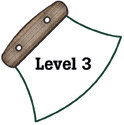|
National Science Education Standards
Think critically and logically to make the relationships between evidence
and explanations. Thinking critically about evidence includes deciding
what evidence should be used and accounting for anomalous data. Specifically,
students should be able to review data from a simple experiment, summarize
the data, and form a logical argument about the cause-and-effect relationships
in the experiment. Students should begin to state some explanations in
terms of the relationship between two or more variables. (Page 145)
Communicate scientific procedures and explanations. With practice, students
should become competent at communicating experimental methods, following
instructions, describing observations, summarizing the results of other
groups, and telling other students about investigations and explanations.
(Page 148)
Scientific explanations emphasize evidence, have logically consistent
arguments, and use scientific principles, models, and theories. The scientific
community accepts and uses such explanations until displaced by better
scientific ones. When such displacement occurs, science advances. (Page
148)
Science advances through legitimate skepticism. Asking questions and
querying other scientists’ explanations is part of scientific inquiry.
Scientists evaluate the explanations proposed by other scientists by examining
evidence, comparing evidence, identifying faulty reasoning, pointing out
statements that go beyond the evidence, and suggesting alternative explanations
for the same observations. (Page 148)
Science requires different abilities, depending on such factors as the
field of study and type of inquiry. Science is very much a human endeavor,
and the work of science relies on basic human qualities, such as reasoning,
insight, energy, skill, and creativity, as well as on scientific habits
of mind, such as intellectual honesty, tolerance of ambiguity, skepticism,
and openness to new ideas. (Page 170)
It is part of scientific inquiry to evaluate the results of scientific
investigations, experiments, observations, theoretical models, and the
explanations proposed by other scientists. Evaluation includes reviewing
the experimental procedures, examining the evidence, identifying faulty
reasoning, pointing out statements that go beyond the evidence, and suggesting
alternative explanations for the same observations. Although scientists
may disagree about explanations of phenomena, about interpretations of
data, or about the value of rival theories, they do agree that questioning,
response to criticism, and open communication are integral to the process
of science. As scientific knowledge evolves, major disagreements are eventually
resolved through such interactions between scientists. (Page 171)
|
|
Benchmarks
Know that often different explanations can be given for the same evidence,
and it is not always possible to tell which one is correct. (Page 287)
|

